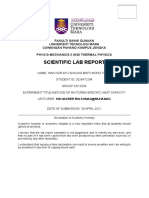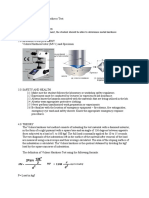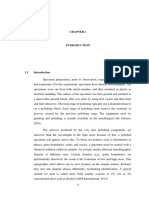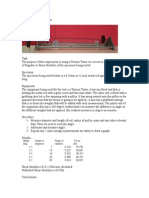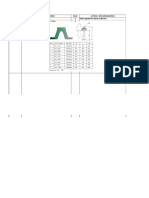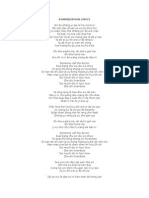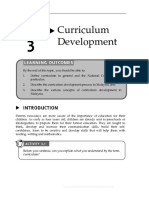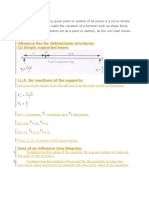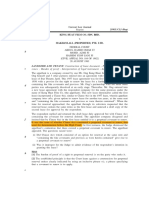Lab Pendulum 2
Lab Pendulum 2
Uploaded by
Alif Aikal Che HatCopyright:
Available Formats
Lab Pendulum 2
Lab Pendulum 2
Uploaded by
Alif Aikal Che HatCopyright
Available Formats
Share this document
Did you find this document useful?
Is this content inappropriate?
Copyright:
Available Formats
Lab Pendulum 2
Lab Pendulum 2
Uploaded by
Alif Aikal Che HatCopyright:
Available Formats
UNIVERSITI TEKNOLOGI MARA Faculty Of Mechanical Engineering
Applied Mechanics Lab (MEC424)
TITLE: Physical Pendulum - Wooden Pendulum OBJECTIVE: At the end of the session, students should be able to : 1) To determine the relation between the period (T) of oscillation of a simple pendulum with verify 3 types of different specimens. 2) To determine the center of gravity of a connecting rod, as well as the radius of gyration about the center of gravity by using compound pendulum. 3) Determine the mass moment of inertia, (Ig & Io ) by oscillation and manual calculation.
APPARATUS: Universal Vibration System Apparatus 1) Wooden pendulum 2) Vee support, cylindrical support 3) Ruler 4) Stopwatch
1|Page
UNIVERSITI TEKNOLOGI MARA Faculty Of Mechanical Engineering
Applied Mechanics Lab (MEC424)
The apparatus used for the experiment.
PROCEDURE: 1. The dimension for the wooden pendulum is taken ( thickness, width and length ) 2. Vee support is inserted into the hole of the wooden pendulum. 3. The wooden pendulum is hanging at the testing apparatus to swing it. 4. The wooden pendulum was swing from right at 15o , and time for 10 complete cycle was taken. 5. Step 4 was repeated for swinging the pendulum from left. 6. Step 2 to 5 was repeated for cylindrical support for another hole of wooden pendulum.
THEORY: Physical pendulum In this case, a rigid body instead of point mass - is pivoted to oscillate as shown in the figure. There is no requirement of string. As a result, there is no tension involved in this case. Besides these physical ramifications, the working of compound pendulum is essentially same as that of simple pendulum except in two important aspects:
2|Page
UNIVERSITI TEKNOLOGI MARA Faculty Of Mechanical Engineering
Applied Mechanics Lab (MEC424)
Gravity acts through center of mass of the rigid body. Hence, length of pendulum used in equation is equal to linear distance between pivot and center of mass (h).
The moment of inertia of the rigid body about point suspension is not equal to mL2 * as in the case of simple pendulum. The time period of compound pendulum, therefore, is given by :
In case we know MI of the rigid body, we can evaluate above expression of time period for the physical pendulum. For illustration, let us consider a uniform rigid rod, pivoted from a frame as shown in the figure. Clearly, center of mass is at a distance L/2 from the point of suspension :
h= L/2 Now, MI of the rigid rod about its center is:
We are, however, required to evaluate MI of the rod about the point of suspension, i.e. O. Applying parallel axes theorem,
3|Page
UNIVERSITI TEKNOLOGI MARA Faculty Of Mechanical Engineering
Applied Mechanics Lab (MEC424)
Putting in the equation of time period, we have:
The important thing to note about this relation is that time period is still independent of mass of the rigid body. However, time period is not independent of mass distribution of the rigid body. A change in shape or size or change in mass distribution will change MI of the rigid body about point of suspension. This, in turn, will change time period.
Further, we should note that physical pendulum is an effective device to measure g. As a matter of fact, this device is used extensively in gravity surveys around the world. We only need to determine time period or frequency to determine the value of g. Squaring and rearranging,
Point of oscillation
We can think of physical pendulum as if it were a simple pendulum. For this, we can consider the mass of the rigid body to be concentrated at a single point as in the case of simple pendulum such that time periods of two pendulums are same. Let this point be at a linear distance Lo from the point of suspension. Here,
The point defined by the vertical distance, "Lo , from the point of suspension is called point of oscillation of the physical pendulum. Clearly, point of oscillation will change if point of suspension is changed. 4|Page
UNIVERSITI TEKNOLOGI MARA Faculty Of Mechanical Engineering
Applied Mechanics Lab (MEC424)
SAMPLE OF CALCULATIONS:
Experimental Result
Point 1
Point For Point 1 2 3 Average T1 14.65 14.5 14.5 14.53 2 T2 14.1 14.0 14.1 14.07
1 period of oscillation , T1 T2 Point 1
= 14.53 / 10 = 1.453 s = 14.07 / 10 = 1.407 s
T = 2
L1 g
(1.453)2 = (2 )2 ( L1 / 9.81 ) L1= 0.5246 m Point 2
T2 = 2
L2 g
5|Page
UNIVERSITI TEKNOLOGI MARA Faculty Of Mechanical Engineering
Applied Mechanics Lab (MEC424)
(1.459)2 = (2 )2 ( L2 / 9.81 ) L2 = 0.529 m
Component 1
Component 2
Component 3
Component 1 Length Height Width Volume 80cm 1cm 8cm 640cm3
Component 3 1cm 45cm 1cm 45cm3 Diameter Height Volume
Component 2 2.5cm 1cm 4.9cm3
So, Total volume, VT = V1 ( V2 + V3 ) = 640 ( 45 + 4.9 ) = 590.1 cm3 Given mass, m = 0.6 kg Density, = m / vtotal = 0.6 kg / 590.1 10-6 = 1016.78 kg/m3 To obtain the mass for each component, 6|Page
UNIVERSITI TEKNOLOGI MARA Faculty Of Mechanical Engineering
Applied Mechanics Lab (MEC424)
m1= v = 1016.78 (64010-6) = 0.6507 kg
m3=v = 1016.78 (4510-6) = 0.0458 kg
m 2= v = 1016.78 (4.910-6) = 4.982 10-3 kg
X= 73 cm
= 15
rG = x (L2 x) / (L1 + L2 - 2x) = 0.73 ( 0.529 0.73 ) / ( 0.5203 + 0.529 - 1.46 ) = -0.1467 / -0.4107 = 0.3572 m to obtain I0 :
T = 2
IO mgrg
At point 1 (T1)2 = (2 )2 ( I01 / mgrG ) (1.453) 2 = (2 )2 ( I01 / 0.6 9.81 0.3572) I01 = 0.1124 kg.m2 7|Page
UNIVERSITI TEKNOLOGI MARA Faculty Of Mechanical Engineering
Applied Mechanics Lab (MEC424)
At point 2 (T2)2 = (2 )2 ( I02 / mgrG ) (1.407) 2 = (2 )2 ( I02 / 0.6 9.81 0.3572 ) I02 = 0.1054 kg.m2
To obtain IG :
L1 = (IG1 + mrG) / mrG
Thus, IG = mrG (L rG)
At point 1 IG1 = mrG (L1 rG) = (0.6)(0.3572)(0.5203-0.3572) = 0.035 kg.m2 At point 2 IG2 = mrG (L2 rG) = (0.6)(0.3572)(0.529-0.3572) = 0.0368 kg.m2
Theoretical Result
Area (A1) = 73 8 = 584 cm2
Area (A2) = = 3.142(1.25)2 = 4.909cm2
Area (A3) = 45 1 = 45cm2
8|Page
UNIVERSITI TEKNOLOGI MARA Faculty Of Mechanical Engineering
Applied Mechanics Lab (MEC424)
Total area, At = A1 ( A2 + A3 ) = 534.091 cm2
Hanging at point 1 8cm
73cm
*Height = 1cm Y= = 36.5 (A1) 15(A3).25(A2) - 50. At = 19037.36 / 534.091 = 35.644 cm
To obtain Io, Moment of Inertia :
I0 = IG + md2
For component 1 I01 = 1/12 ( mh12 ) + md12 = 1/12 (0.65070.82) + (0.6507(0.365) 2) 9|Page
UNIVERSITI TEKNOLOGI MARA Faculty Of Mechanical Engineering
Applied Mechanics Lab (MEC424)
= 0.1214 kg.m3
For component 2 I02 = 1/4 mr22 ) + md22 = 1/4 (4.982 10-3 0.01252) + (4.982 10-3 0.0125 2) = 9.730510-7 kg.m3 For component 3 I03 = 1/12 ( mh32 ) + md32 = 1/12 ( 0.04580.45 2 ) + ( 0.04580.505 2 ) = 0.01245 kg.m3
So, Io,total = I01 + I02 + I03 = 0.1214 - 9.730510-7 - 0.01245 = 0.10895 kg.m2
Io,total = IG + md2 Thus, IG can be obtain IG = Io,total - md2
= 0.10895 (0.6)(0.356442) = 0.03272 kg.m2
10 | P a g e
UNIVERSITI TEKNOLOGI MARA Faculty Of Mechanical Engineering
Applied Mechanics Lab (MEC424)
Hanging at point 2
8cm
Y 73cm
*Height = 1cm Y= = 36.5 (A1) 71.75(A2) 22.5(A3) At = 19951.28 / 534.091 = 37.356 cm To obtain Io, Moment of Inertia:
I0 = IG + md2
For component 1 I01 = 1/12 ( mh12 ) + md12 = 1/12 (0.65070.82) + (0.65070.3652) 11 | P a g e
UNIVERSITI TEKNOLOGI MARA Faculty Of Mechanical Engineering
Applied Mechanics Lab (MEC424)
= 0.1214 kg.m3
For component 2 I02 = 1/4 mr22 ) + md22 = 1/4 (4.982 10-3 0.01252) + (4.982 10-3 0.7175 2) = 2.564910-3 kg.m3 For component 3 I03 = 1/12 ( mh32 ) + md32 = 1/12 ( 0.04580.45 2 ) + ( 0.04580.2252 ) = 3.0915 10-3 kg So, Io,total = I01 + I02 + I03 = 0.1214 - 2.564910-3 - 3.0915 10-3 = 0.1157 kg.m2 Io,total = IG + md2
Thus, IG can be obtain IG = Io,total - md2 = 0.1157 (0.6)(0.37356)2 = 0.03202 kg.m2
Percentage Error
At point 1 : 12 | P a g e
UNIVERSITI TEKNOLOGI MARA Faculty Of Mechanical Engineering
Applied Mechanics Lab (MEC424)
I01 = 0.1115 kg.m2 (experiment) = 0.10895 kg.m3 (theory) So, Percentage error = 0.1115 0.10895 x 100% 0.1115 = 2.287%
IG1 = 0.035 kg.m2 (experiment) = 0.03272 kg.m2 (theory) So, Percentage error = 0.035 0.03272 x 100% 0.035 = 6.514% At point 2: I02 = 0.1134 kg.m2 (experiment) = 0.1157 kg.m2 (theory)So, Percentage error = 0.1134 0.1157 x 100% 0.1116 = 2.061%
IG2 = 0.0368 kg.m2
(experiment)
= 0.03202 kg.m2 (theory) So, Percentage error = 0.0368 0.03202 x 100% 0.0368 = 12.989%
13 | P a g e
UNIVERSITI TEKNOLOGI MARA Faculty Of Mechanical Engineering
Applied Mechanics Lab (MEC424)
DISCUSSION: During the experiment, we found out there are errors identified that affects the results. The value k is different compare to the theoretical value because of errors as below; Human error This experiment is conducted by human so there must be some error in terms of readings and procedure. Parallax error is one of the most common errors in conducting the experiment and then, the handling of stopwatch timing is not accurate. Device error The apparatus used is not reliable because one of the parts of the apparatus (protractor) is gone but the angle still can be obtained by using the protractor which is drawn by pencil. Environment factors This factor slightly can be taken as a minor cause of the error. The experiment been ran out in a very conducive laboratory but possibilities of the present of blowing wind must be considered.
CONCLUSION: From this experiment, we obtained the experimental value is slightly differs to the theoretical value. From the discussion above, we found out the reading is not accurate. Minimize the parallax error (reading been taken parallel to the eyes). The experiment is best conducted in a vacuum. Precising the value by taking readings more than 2 or 3 times (during handling the stopwatch) and get the average. To obtain a better experiment result, a new set of apparatus must be replaced with the unreliable one. Since the percentage error is less than 15%, we can conclude the experiment is succeed and the objective of the experiment is achieved. 14 | P a g e
UNIVERSITI TEKNOLOGI MARA Faculty Of Mechanical Engineering
Applied Mechanics Lab (MEC424)
REFERENCES Engineering Mechanics Dynamics, 11th Edition In SI Units by R.C Hibbeler Publisher : Pearson Prentice Hall http://cnx.org/content/m15585/latest/
15 | P a g e
You might also like
- Lab Report Free Vibration Experiment - Natural Frequency of SpringDocument51 pagesLab Report Free Vibration Experiment - Natural Frequency of Springasyraaf md diwi100% (2)
- Amherst College Common Language GuideDocument40 pagesAmherst College Common Language GuideThe College Fix69% (16)
- Dynamic Experiment 1 (Vibration)Document16 pagesDynamic Experiment 1 (Vibration)Apostrophe Fareez Imprezza100% (1)
- Temperature Measurement - Group 6Document14 pagesTemperature Measurement - Group 6Loranie SulukangNo ratings yet
- Lab Report Phy210 - Mac 2021 - Ogos 2021Document8 pagesLab Report Phy210 - Mac 2021 - Ogos 2021Yuu ShaNo ratings yet
- Machine Dynamics Belt Friction Lab ReportDocument6 pagesMachine Dynamics Belt Friction Lab ReportnewbuieNo ratings yet
- Forced Vibration Experiment - Resonance of Spring PDFDocument121 pagesForced Vibration Experiment - Resonance of Spring PDFasyraaf md diwi100% (2)
- Lab Report On Inertia WheelDocument4 pagesLab Report On Inertia WheelAngela Leong Feng Ping100% (4)
- Calibration of A Pressure GaugeDocument7 pagesCalibration of A Pressure Gaugeneutron_8788% (17)
- Lab 3 TorsionDocument8 pagesLab 3 TorsionFarid NajandNo ratings yet
- Mec424 Dynamics Exp 2Document16 pagesMec424 Dynamics Exp 2Zulfazli SofiuddinNo ratings yet
- Experiment 2Document3 pagesExperiment 2Apet GriffinNo ratings yet
- Materials Science Lab ReportDocument3 pagesMaterials Science Lab ReportNedjmah Lecheheb50% (2)
- Lab 2 Physical PendulumDocument15 pagesLab 2 Physical Pendulumneenoonaa100% (1)
- Dynamics Lab Report (Forced Vibration)Document7 pagesDynamics Lab Report (Forced Vibration)Wahiduzzaman Zaki0% (2)
- Lab Material 1 (Emd4m8b-G7)Document36 pagesLab Material 1 (Emd4m8b-G7)shahril shaharoniNo ratings yet
- Kinetic Friction: Experiment #13Document8 pagesKinetic Friction: Experiment #13kate anne del castroNo ratings yet
- Mec424 Dynamics Exp 1Document14 pagesMec424 Dynamics Exp 1Zulfazli SofiuddinNo ratings yet
- Rolling Disk Lab Report Applied DynamicsDocument7 pagesRolling Disk Lab Report Applied DynamicsAliNo ratings yet
- Lab Sheet 2 - Microstructure Study of Ferrous and Non Ferrous - StudentDocument2 pagesLab Sheet 2 - Microstructure Study of Ferrous and Non Ferrous - StudentimfendiNo ratings yet
- Lab Report Physics Hooke's LawDocument11 pagesLab Report Physics Hooke's LawAbu Huzaifah100% (1)
- Lab 3 Material Science - G4Document35 pagesLab 3 Material Science - G4Syafiq Fauzi100% (1)
- Phy210 Specific Heat Capacity Lab Report 1Document11 pagesPhy210 Specific Heat Capacity Lab Report 1Athirah ArshadNo ratings yet
- Undamped Free Vibration-Lab Report: Author: Muhammad Sohaib AlamDocument11 pagesUndamped Free Vibration-Lab Report: Author: Muhammad Sohaib AlamfaqhrulNo ratings yet
- Strength Lab Report Experiment #4 "Creep Test": University of Jordan School of Engineering Mechanical DepartmentDocument14 pagesStrength Lab Report Experiment #4 "Creep Test": University of Jordan School of Engineering Mechanical Departmentjohn rozz bbNo ratings yet
- Mec 424 - Laboratory Report Tensile TestDocument12 pagesMec 424 - Laboratory Report Tensile TestShameerul Akif100% (1)
- Torsion TestDocument16 pagesTorsion TestEmaan W KaNo ratings yet
- Vibration Lab 2 Belt Friction Lab ReportDocument15 pagesVibration Lab 2 Belt Friction Lab ReportYann YeuNo ratings yet
- Lab Report Mass Spring System Omar Nizar2Document31 pagesLab Report Mass Spring System Omar Nizar2Omar MustafaNo ratings yet
- Introduction of Magnetic Particle TestingDocument7 pagesIntroduction of Magnetic Particle TestingKhair Jamiulanwar100% (2)
- Experiment No.04 (For Sir)Document7 pagesExperiment No.04 (For Sir)Waqar Hassan100% (1)
- CVE 230. Lab Report 4 (Torsion Testing) .Document4 pagesCVE 230. Lab Report 4 (Torsion Testing) .Juan Villa100% (1)
- Belt Friction Full ReportDocument8 pagesBelt Friction Full ReportPristine Fx100% (2)
- Lab 1 Metallography Specimen Preparation - RepairDocument6 pagesLab 1 Metallography Specimen Preparation - RepairMifzal IzzaniNo ratings yet
- Lab Report 1 The Simple PendulumDocument3 pagesLab Report 1 The Simple PendulumMohammedSalahNo ratings yet
- Lab Report Phy (Specific Heat Capacity) Aidil AfiqDocument7 pagesLab Report Phy (Specific Heat Capacity) Aidil Afiqaidil afiqNo ratings yet
- Physics Lab Assessment 7 PARTA - The Conservation of Energy (Elastic Potential Energy) Practical ReportDocument8 pagesPhysics Lab Assessment 7 PARTA - The Conservation of Energy (Elastic Potential Energy) Practical ReportMark Riley67% (3)
- TorsionTest Lab ReportDocument2 pagesTorsionTest Lab ReportPranksterz Starz100% (1)
- School of Engineering and Physics EE102 Lab # 6Document6 pagesSchool of Engineering and Physics EE102 Lab # 6Nawaz AliNo ratings yet
- Lab 3 PDFDocument18 pagesLab 3 PDF000No ratings yet
- Lab Report 05Document24 pagesLab Report 05sandeepa nakanadalaNo ratings yet
- Coefficient of Friction Lab Write UpDocument5 pagesCoefficient of Friction Lab Write UpPOH HSIN TANNo ratings yet
- Shear Force Lab ReportDocument8 pagesShear Force Lab ReportJack WillyNo ratings yet
- Charpy Impact TestDocument2 pagesCharpy Impact TestGanim Shed100% (1)
- Experiment 2: Electrochemistry (Electrochemical Cell and Thermodynamic Functions)Document6 pagesExperiment 2: Electrochemistry (Electrochemical Cell and Thermodynamic Functions)Hidayah Dayah100% (1)
- Damped Simple Harmonic MotionDocument15 pagesDamped Simple Harmonic MotionIoannis GaroufalidisNo ratings yet
- Hookes Law ExperimentDocument3 pagesHookes Law ExperimentKhairul Razmin AbdurakmanNo ratings yet
- Simple Pendulum ExperimentDocument3 pagesSimple Pendulum ExperimentSubesh ShanmugamNo ratings yet
- Exp 04 - Coefficient of FrictionDocument4 pagesExp 04 - Coefficient of FrictionTonyNo ratings yet
- Tensile Report Group7Document21 pagesTensile Report Group7muhd hariz100% (1)
- Lab Report Exp 2 chm432Document9 pagesLab Report Exp 2 chm432pufff witchesNo ratings yet
- Stefan-Boltzmann Law: Lab ReportDocument12 pagesStefan-Boltzmann Law: Lab ReportZeenat RanaNo ratings yet
- Experiment 4: Deflection of Cantilever Beam TestDocument6 pagesExperiment 4: Deflection of Cantilever Beam Test0728617No ratings yet
- Your Name: Ulises Jose Corona Name of The Course: MAE2160 Materials Science Lab Date: Report DateDocument7 pagesYour Name: Ulises Jose Corona Name of The Course: MAE2160 Materials Science Lab Date: Report DateUlises Corona100% (4)
- Bernoulli's TheoremDocument12 pagesBernoulli's TheoremNur Falini Mohd Sukkri100% (3)
- SM4 Laminate ProcessingDocument8 pagesSM4 Laminate ProcessingMel DNo ratings yet
- LAB DYNAMICS PENDULUM LatestDocument9 pagesLAB DYNAMICS PENDULUM LatestTorentox OctopusNo ratings yet
- Wooden PendulumDocument13 pagesWooden PendulumSafrin Mazlan100% (1)
- Umar Lab ReportDocument24 pagesUmar Lab ReportMia HussainNo ratings yet
- Dynamic Lab 2 Physical PendulumDocument24 pagesDynamic Lab 2 Physical Pendulumadib haikalNo ratings yet
- Lab Sheet Report DynamicDocument23 pagesLab Sheet Report Dynamic2022822356No ratings yet
- Catalogue Fenders ParameterDocument28 pagesCatalogue Fenders ParameterAlif Aikal Che HatNo ratings yet
- Kaspersky Key and InstructionDocument4 pagesKaspersky Key and InstructionAlif Aikal Che HatNo ratings yet
- Fender Design GuideDocument4 pagesFender Design GuideAlif Aikal Che HatNo ratings yet
- MSL Foundry Bollard CatalogueDocument6 pagesMSL Foundry Bollard CatalogueAlif Aikal Che HatNo ratings yet
- Customer: Bme Logistic SDN BHD PROJECT: STUV 250H X 1100L: Work ScheduleDocument1 pageCustomer: Bme Logistic SDN BHD PROJECT: STUV 250H X 1100L: Work ScheduleAlif Aikal Che HatNo ratings yet
- RP1 Briefing - Student 2Document25 pagesRP1 Briefing - Student 2Alif Aikal Che HatNo ratings yet
- Drying of Processes MaterialsDocument25 pagesDrying of Processes MaterialsAlif Aikal Che HatNo ratings yet
- CPE615 Tutorial 1Document3 pagesCPE615 Tutorial 1Alif Aikal Che HatNo ratings yet
- StatusDocument1 pageStatusAlif Aikal Che HatNo ratings yet
- Che571 Che584 Che594Document7 pagesChe571 Che584 Che594Alif Aikal Che HatNo ratings yet
- Escuela de Educación Básica "Victor Manuel Albornoz" Calle: Isauro Rodriguez y Carlos Berrezueta Email: Teléfono: 072853907Document12 pagesEscuela de Educación Básica "Victor Manuel Albornoz" Calle: Isauro Rodriguez y Carlos Berrezueta Email: Teléfono: 072853907Dieguito AcostaNo ratings yet
- Doing Philosophy v4Document175 pagesDoing Philosophy v4JLenon MendNo ratings yet
- The Journal of Design Strategies. Alternative Fashion SystemsDocument65 pagesThe Journal of Design Strategies. Alternative Fashion SystemsAnonymous GKqp4HnNo ratings yet
- Full Download Process of Research in Psychology 3rd Edition Mcbride Test BankDocument35 pagesFull Download Process of Research in Psychology 3rd Edition Mcbride Test Bankkaloudisloisefxs100% (45)
- Dawkins and DarwinDocument4 pagesDawkins and DarwinIyaElagoNo ratings yet
- Prepared By: Herbert C. Ognita JRDocument28 pagesPrepared By: Herbert C. Ognita JRPixelVoidNo ratings yet
- Module 1 The Road To The Right ChoiceDocument73 pagesModule 1 The Road To The Right ChoiceMaricel Ceyh Gonzales100% (2)
- Heaven VoidDocument2 pagesHeaven Voiday2004jan100% (2)
- THREE MACROEVOLUTIONARY EPISODES Deep TiDocument289 pagesTHREE MACROEVOLUTIONARY EPISODES Deep Tiprouser01No ratings yet
- Theory of ArchitectureDocument5 pagesTheory of ArchitectureJan Nikolai GongoraNo ratings yet
- Wisdom in Positive Psychology: Bhumika K T 20BSHH0011 B.Sc. Psychology (Hons)Document17 pagesWisdom in Positive Psychology: Bhumika K T 20BSHH0011 B.Sc. Psychology (Hons)23msahr154No ratings yet
- Cognition For Human Robot Interaction - Spectra 2014Document4 pagesCognition For Human Robot Interaction - Spectra 2014U.S. Naval Research LaboratoryNo ratings yet
- Ancient Greek - Teach YourselfDocument335 pagesAncient Greek - Teach Yourselfaedicofidia100% (4)
- The Invention of Lying WorksheetDocument2 pagesThe Invention of Lying WorksheetAyané FantaNo ratings yet
- In Search of An Inca - IntroductionDocument17 pagesIn Search of An Inca - IntroductionJosé RagasNo ratings yet
- CSR - Areas & MeasurementDocument37 pagesCSR - Areas & Measurementbookabdi1No ratings yet
- Audit CH 6 and 7Document30 pagesAudit CH 6 and 7Nanon WiwatwongthornNo ratings yet
- Romanization LyricsDocument5 pagesRomanization LyricsCorine CaracasNo ratings yet
- Applied Literary Criticism PaperDocument12 pagesApplied Literary Criticism PaperNindya Syafa AdiningtyasNo ratings yet
- Quasi Judicial Perocedures-1Document18 pagesQuasi Judicial Perocedures-1Pralhad KachareNo ratings yet
- Chapter-1 - Introduction To Business Consulting: For AssociatesDocument0 pagesChapter-1 - Introduction To Business Consulting: For AssociatesChaitra MuralidharaNo ratings yet
- TP2 Discreta - 2012Document5 pagesTP2 Discreta - 2012Lucas VellonNo ratings yet
- 07 Hbec2303 T3Document10 pages07 Hbec2303 T3ivodanNo ratings yet
- Bid'ah - Innovation in Islam: Imam Shafi'S Explanation of The Above HadithDocument5 pagesBid'ah - Innovation in Islam: Imam Shafi'S Explanation of The Above HadithmrpaharyNo ratings yet
- Influence Line For Determinate Structures: (1) Simply Supported BeamDocument7 pagesInfluence Line For Determinate Structures: (1) Simply Supported BeamAhmed SuhailNo ratings yet
- Males, Ages Birth - 36 MonthsDocument13 pagesMales, Ages Birth - 36 MonthsKarren Taquiqui PleteNo ratings yet
- Keng Huat V MakanlallDocument9 pagesKeng Huat V MakanlallFreya MehmeenNo ratings yet
- Character Analysis Eustacia VyeDocument1 pageCharacter Analysis Eustacia VyeBaloch KarawanNo ratings yet
- Inferencing Lesson PlanDocument3 pagesInferencing Lesson Planapi-484650638No ratings yet




